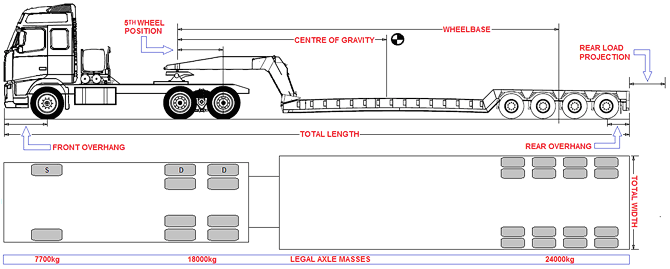ABNORMAL PERMITS
ABNORMAL PERMITS
Exemption permits – commonly known as Abnormal permits
Exemption permits – commonly known as Abnormal permits. “Abnormal” – includes any vehicle or load which does not comply with the requirements of THE NATIONAL ROAD TRAFFIC ACT, 1996 (ACT 93 OF 1996) (AS AMENDED) with sections of the ROAD TRAFFIC ACT, 1989 remaining in force (ACT 29 OF 1989) (AS AMENDED) and REGULATIONS.
The legislator have given the MEC of every Province the powers to consider any application submitted to him for exemption of a load or vehicle which either due to mass and or dimensions does not comply with the requirements of the Act.
Principle Approval
Means the voluntary approval that is obtained by an importer or local manufacturer of a vehicle prior to the import or manufacture in assuring that the vehicle would be granted exemptions in the future.
It is advisable to obtain prior approval in principle before arranging an otherwise illegal event or before an abnormal vehicle is purchased, imported or constructed or the transportation of an abnormal load is undertaken. Assisting with applying for letters giving approval in principle from the Permit Offices. If such letters were not obtained, then an operator or contractor may find that the particular vehicle or event may not be granted exemption permits as required.
Sequ and AV Registration
Register vehicles on the abnormal data base (refer below for a definition of an abnormal vehicle or load)
Permit conditions
Click the link under downloads below to view
Special classification
We can assist you to apply to the Department of Transport for confirmation of the abnormality of your vehicle, to enable you to pay the reduced license fees as provided for in the Act. Regulation 21. We will also assist you with the completion of the ELF1/VLG1 form which must to be submitted to your local licence office together with all the other relevant documentation.
WHAT IS ABNORMAL?
ARTICULATED ABNORMAL VEHICLE
The basic entry level vehicle to be used for the conveyance of abnormal loads.
The legal dimentions for the above vehicle are as follows:
a. LENGTH 18 500mm (INCLUDING ANY PROJECTION)
b. WIDTH 2600mm
c. HEIGHT 4300mm (LOADED HEIGHT)
d. WHEELBASE 10 000mm
The legal axle masses for the above vehicle are as follows:
a. MASS ON FRONT/STEER AXLE 7700kg OR MANUFACTURERS RATING - THE LESSER WILL APPLY
b. MASS ON DRIVE AXLES (GROUP) 18000kg
c. MASS ON TRAILER AXLES (GROUP) 24000kg
d. GROSS COMBINATION MASS (GCM) 56000kg OR a; b AND c ADDED TOGETHER WILL APPLY
Any dimensions and mass outside of these parameters are considered to be abnormal.
1. ABNORMAL LOAD
means an indivisible (for practical purposes) object that, due to it's dimensions and/or mass, cannot be transported on a vehicle or vehicles without exceeding the limitations of the dimensions or mass as described in THE NATIONAL ROAD TRAFFIC ACT, 1996 (ACT 93 OF 1996) (AS AMENDED) with sections of the ROAD TRAFFIC ACT, 1989 remaining in force (ACT 29 OF 1989) (AS AMENDED) and REGULATIONS.
2. ABNORMAL VEHICLE
means a vehicle or a combination of vehicles that, by virtue of its dimensions or mass, or a combination of both, does not comply with the requirements of the Regulations of the road THE NATIONAL ROAD TRAFFIC ACT, 1996 (ACT 93 OF 1996) (AS AMENDED) with sections of the ROAD TRAFFIC ACT, 1989 remaining in force (ACT 29 OF 1989) (AS AMENDED) and REGULATIONS. Permit Offices may declare a vehicle to be legitimately abnormal in term of such regulation.
3. INDIVISABLE LOAD
means a load which cannot, without disproportionate effort, expense or risk of damage, be divided into two or more loads for the purpose of transport on public roads.
4. FRONT OVERHANG
Measured from the furthest point on the front of the vehicle to the centre of the first axle.
5. REAR OVERHANG
Measured from the rearmost axle to the furthest point on the rear fo the vehicle.
6. WHEELBASE
Measured from the kingpin of the trailer to the centre of the trailer rear axle group.
7. PROJECTION REAR LOAD
Projection - Measured from the rear of the vehicle to the end of the load behind the rear end of the vehicle.
VITAL POINTS TO TAKE IN CONSIDERATION BEFORE DEPARTING WITH AN ABNORMAL LOAD OR VEHICLE.
The original permit must be in the vehicle
Permit must at all times be signed by the person responsible for the load or vehicle.
The permit conditions must be explained to the driver.
Red flags measuring at least 600mm in diameter must be placed at the outer corners of the load or vehicle. The widest point of the load, if the load is wider than the vehicle, shall normally be the point where the flags should be mounted.
The abnormal warning boards must be manufactured to the prescribed requirements as per the TRH 11 condition 12 a.
ABNORMAL shall appear on the front and the rear of the vehicle.
Board size: Length - 2000mm, Height - 300mm
Modified “E” letters as per the Road Traffic Regulations, at least 200mm high
Amber warning lights.

